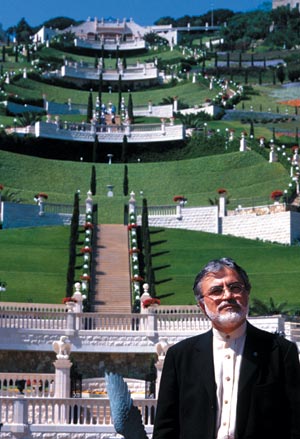BAFA © 2010. All material here is copyrighted. See conditions above. |
Eliza Rasiwala
works at the Bahá´í International Centre, Israel
|

|
Water and light:
two works by Bahá'í architect
Fariburz Sahba
by Eliza Rasiwala.
In recent years, many a visitor to New Delhi, the capital city of India, has come upon a white, lotus-shaped structure standing amidst vast gardens, on the outskirts of a busy commercial section of the city. This is the Bahá’í House of Worship of the Indian subcontinent, popularly known as the Lotus Temple, and often described as the "Taj Mahal of the 20th century". Inaugurated in December of 1986, the Bahá’í House of Worship in New Delhi is the latest in a chain of seven temples built by the followers of the Bahá’í Faith in different parts of the world. Its architect is Iranian born Fariburz Sahba, who is now a citizen of Canada.
|
The architect conceived it as a lotus flower, a completely symmetrical form. But the choice of a design for the Bahá’í Temple was a difficult one, as he explains:
"On the one hand, a Bahá’í House of Worship should be designed to symbolize the freshness of the Bahá’í Faith, the world’s youngest religion. On the other hand, it should act as a constant reminder to the basic
|

Photograph by Raghu Rai.
|
Bahá’í teaching that the spiritual essence of all the religions is one. Therefore the challenge before me was to prepare a design unique in form, nevertheless appealing to the aesthetic sense of people of different backgrounds."
Based on these considerations he undertook a study in the hope of preparing a design which, while it would in no way imitate any of the existing architectural schools of India, would still remain familiar and relate to the heart of the Indian people.
From ancient times the lotus has been revered in India as a symbol of purity and a manifestation of the divine. Mentioned in the oldest Veda, Rid-Veda, it plays a prominent part in the mythology of Brahmanism. In the epic Mahabharata the Creator Brahma is described as having sprung from the lotus that grew out of Lord Vishnu’s navel when that deity lay absorbed in meditation. In Buddhist folklore one of the Bodhisattvas is represented as born from a lotus holding a lotus bloom in his hand. In Islamic architecture the shape of a lotus often appears in the prayer niche of mosques. In fact, the dome of the Taj Mahal is shaped like a lotus bud, and the flower appears as a recurring motif in the interior of this monument. Today, the lotus is recognized as the national flower of India....
|
Excerpt from, Arts Dialogue, February 2001, pages 16 - 19
|

Arts Dialogue, Dintel 20, NL 7333 MC, Apeldoorn, The Netherlands
email: bafa@bahai-library.com
|
|

